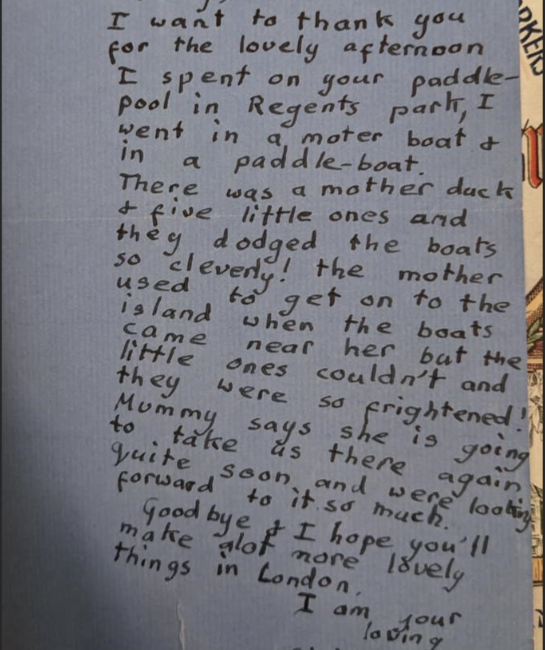
Photograph courtesy of the @LSELibrary collections
Perhaps you might be interested to learn that there are two Inverclyde place names honouring the memory of two very different men, both named George. One is King George V (1865 – 1936) who is commemorated by the King George V Playing Fields in Port Glasgow and the other is Lansbury Street in Gibshill, which commemorates the politician George Lansbury, who was First Commissioner of Works in Ramsay MacDonald’s 1929 Government.
During his time as a cabinet minister, George Lansbury greatly improved public parks, municipal golf courses, public baths and outdoor swimming pools, making them more accessible to ordinary people.
In his fine book ‘Good Old George’, Bob Holman describes how “Under Lansbury’s direction, railings were pulled down, shelters for parents put up, paddling and swimming pools for children constructed, play and recreation equipment installed”.
Similarly, King George was equally interested in providing working people with an environment and opportunity for open air exercise, ‘for the benefit of individual well-being and the general welfare of the nations.’
Therefore, in 1936 following the king's death, it was decided that a number of common playing fields would be established throughout Britain for the use and enjoyment of the people. It was agreed that these playing fields would be styled 'King George's Field' distinguished with two heraldic panels in memory of the King, just as we have in Port Glasgow today.
Despite their differences, both George Lansbury and King George V got on very well whenever they met to discusses the idea of royal parks and their shared interest in the wellbeing of workers, families, children, communities and the country.
Today, we often think of things like wellbeing, good mental health and outdoor therapy activities, as being very modern concepts but in reality, both George Lansbury and King George V made it their business to improve recreational facilities and bring more working people into public parks and green spaces, almost 100 years ago.
It is exactly this noble legacy of improving our surroundings and creating spaces for recreation, that Inverclyde Community Development Trust continues today through its Inverclyde Council funded Environmental Works project, which creates paid training and employment opportunities, while making improvements to our community.
Indeed, this way of thinking lies deeply imbedded within Inverclyde Community Development Trust’s DNA. In the early 1980s our first chairperson, the late Donald Muirhead and our founder CEO Jim Bristow, developed and conceived of an idea called ‘Recreational Services & Education’ which combined learning with leisure. From this idea came the Trust’s mission to create jobs, provide services and remove barriers.
Donald and Jim had previously managed the former Hector McNeil public baths in Greenock before establishing The Trust, and Donald was also a well-known local swimming coach for many years too.
More so, it is no coincidence that in the early 20th century, a huge number of outdoor pools opened across Britain, including Gourock Outdoor Pool in 1909. These new pools were named “lidos” taken from the Italian for coast, and their construction was part of the post-war public works programme, which aimed to create jobs and promote health. The same kind of job creation and health
improvement programmes that Jim and Donald later established through ‘Recreational Services & Education’, which The Trust continues to deliver today on behalf of Inverclyde Council.
As such, we Inverclyders are fortunate enough to enjoy one the best-preserved outdoor pools in Britain, we also have the Rankin Park Bike Track, Gourock Park, Murdieston boat pond, Coronation Park and the municipal golf course at Whinhill, all of which have been worked on by The Trust trainees over the years.
We also have wonderful community gardens and growing spaces at Belville Community Garden, Broomhill Gardens, Park Lea Branching Out Project and Shore Street Gardens. Yet, the creation of all these vitally important spaces are not our only connection with the legacy of George Lansbury.
Lansbury also led the famous Poplar Rates Revolt which was a tax protest which took place in London in 1921 and it is also worth noting that we also have a Poplar Street nearby Lansbury Street in Gibshill today.
With all this history in mind, The Trust will be hosting a series of heritage health walks and history talks next Spring, as part of the Port Glasgow 2025 celebrations and one of these walks will be ‘The Two George Trail’, from Gibshill to the King George V Playing Fields in Port Glasgow, stopping at Port Glasgow Public Baths, where a memorial stone commemorates the shipbuilder Joseph Russel’s donation in 1893. The baths were formally opened in 1894 with a procession of the town’s societies and organisations.
We will be inviting everyone to come along, to discuss and reflect upon the importance of civil society and public spaces which are open for all. We plan to celebrate and explore our shared common life together and invite others to continue to build their own mutual self-interest, much like the two Georges putting aside their difference for the pursuit of the common good.
Finally, in 1930 a little girl wrote to George Lansbury thanking him for ‘making lovely things’ after a summer’s day out at a new public paddling pool in Regent’s Park. Our own Trust Environmental Works trainees are currently carrying out improvements at the King George V Playing Fields in Port Glasgow, so hopefully we are also ‘making lovely things’ in our own community too and will continue to do so for many years to come; because this is where the good life to be found.


